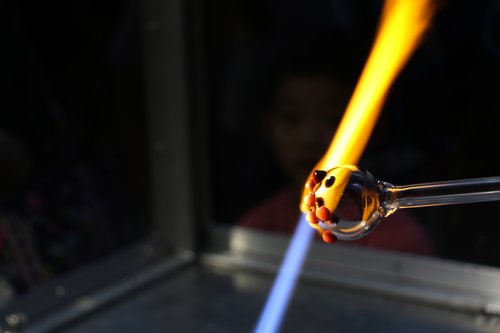
Photo from Gather Glass, gatherglass.com
There’s something mesmerizing about watching a glassblower at work. The way they shape the molten glass, spinning and blowing it into delicate works of art before your eyes. It’s like witnessing a form of alchemy, transforming ordinary materials into something extraordinary through an ancient process.
The origins of glassblowing can be traced back over 2,000 years to the ancient Phoenicians and Romans. According to legend, Phoenician merchants were carrying bundles of natron (a type of soda ash) when they stopped to eat near the mouth of the River Belus. They propped their bundles on some blocks of nitrate and built a fire. In the intense heat, the nitrate and natron fused together into a liquid that cools into solid pools of glass. The first accidental glassmakers!
The glassblowing process really took off in the 1st century BC in the region surrounding modern-day Israel, Lebanon and Syria. Glassblowers discovered that by blowing through a hollow metal rod into the molten glass, they could shape and inflate it into vessels and other useful objects. An entire artistic tradition was born.
Today’s glassblowers are carrying on this time-honored tradition with their own creative flair. The process begins by melting a mixture of sand, soda ash, lime and other ingredients in a special furnace heated to over 2,000°F. The molten glass is scooped up on the end of a hollow steel blowpipe coated in a clay mixture.
The glassblower then blows air through the pipe, inflating and expanding the molten glass into the rough shape of their intended piece. They’ll roll the glowing-hot glass on a steel table called a marver to shape it further with wooden blocks and other specialized tools. Color can be added by dipping the piece into pots of colored glass particles.
The shaping gets progressively more intricate, as the glassblower adds details like stems for goblets, handles for pitchers, or elaborate decorative flourishes. At just the right moment when the glass is perfectly molten and workable, it’s placed into a specially heated oven to slowly cool and anneal into its final solid form.
Watching an experienced glassblower is like witnessing an elegant dance between human and material. Each step is choreographed yet improvisational, an expression of both technical mastery and creative vision. From functional vessels to whimsical sculptural pieces, they coax the molten glass into whatever shape their artistic minds can envision.
Glassblowing demonstrates human ingenuity at its finest, where an ancient process pioneered millennia ago is still used to craft objects of beauty and utility today. Through the twisting swirls of color and transcendently glowing forms, we glimpse the magic of an art form with the power to take our breath away.


